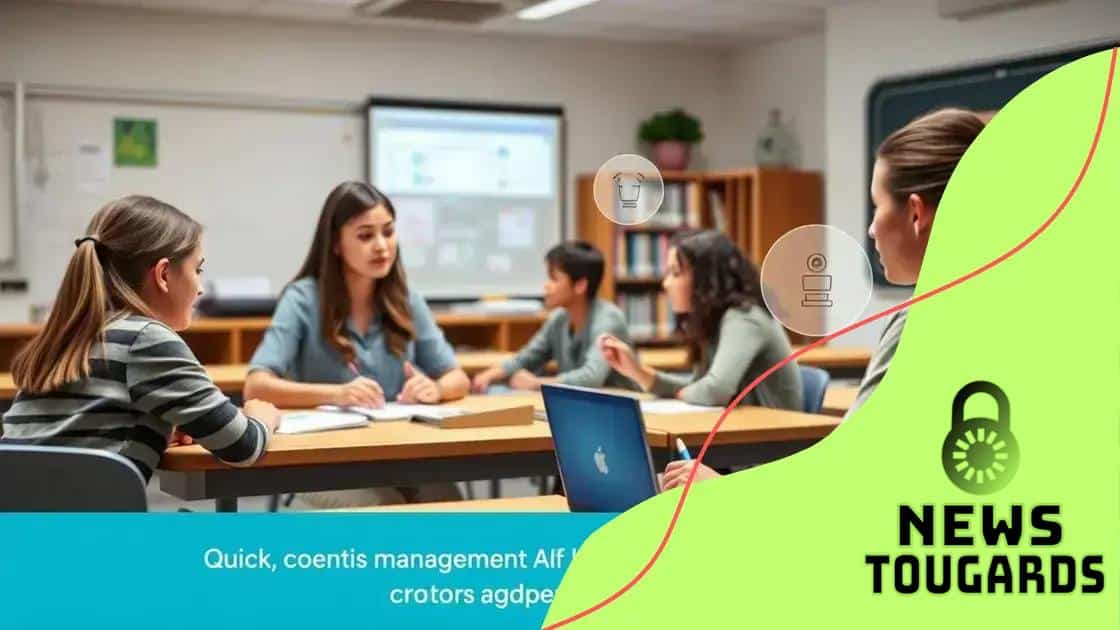AI’s potential to address learning disabilities in students

AI’s potential to address learning disabilities in students lies in its ability to personalize education, automate tasks for teachers, and create adaptive learning environments that cater to individual student needs.
AI’s potential to address learning disabilities in students is gaining recognition in educational circles. Imagine a classroom where technology adapts to each student’s unique needs, enhancing learning outcomes and fostering engagement. Curious about how this works? Let’s dive in.
Understanding learning disabilities and their impact
Understanding learning disabilities is crucial for effective educational support. These disabilities affect how students process information, making traditional teaching methods challenging. By recognizing their unique needs, educators can create a supportive environment.
Types of Learning Disabilities
Learning disabilities can take many forms. Some common types include:
- Dyslexia: Difficulty in reading and interpreting words.
- Dysgraphia: Challenges with writing and organization.
- Dyscalculia: Struggles with understanding numbers and mathematical concepts.
- Auditory Processing Disorder: Difficulty in processing sounds and understanding spoken language.
Each disability requires specific strategies to help students succeed. Identifying the type of disability is a key first step in offering the right support. For instance, students with dyslexia benefit from phonemic awareness exercises, while those with dyscalculia may use visual aids for math concepts.
The Impact on Learning
Learning disabilities can profoundly impact a student’s academic journey. Without proper support, students may experience frustration, low self-esteem, and disengagement. It’s essential to draw connections between their struggles and the support they need.
When students feel understood and supported, their confidence grows. For instance, personalized learning plans can help track progress and adapt teaching methods to better meet their diverse needs. AI tools can analyze performance data to suggest tailored solutions, providing insights that help educators in crafting effective teaching strategies.
Creating a classroom atmosphere that embraces diversity fosters acceptance and understanding among peers. This environment not only aids in academic achievement but also promotes social skills and emotional well-being. The significance of addressing learning disabilities extends beyond just academics; it shapes the whole student experience.
How AI can personalize learning experiences
AI has great potential to personalize learning experiences for students with diverse needs. By analyzing data on student performance, AI can tailor educational content to fit individual strengths and weaknesses. This approach makes learning more engaging and effective.
Adaptive Learning Systems
One of the key applications of AI in education is through adaptive learning systems. These systems adjust the difficulty and type of content based on a student’s progress. They provide:
- Real-time feedback: Students receive instant evaluations on their work, helping them understand their mistakes.
- Customized pathways: Learning paths are created around each student’s needs, making education more accessible.
- Engagement: Students are more motivated when content is suited to their interests and abilities.
Through these adaptive systems, students not only learn at their own pace but also build confidence in their abilities. For example, a student struggling with math will receive additional exercises focused on their specific challenges, enabling steady progression.
AI-Driven Support Tools
Another significant advancement is in the development of AI-driven support tools for both students and educators. These tools can help identify learning gaps and recommend resources tailored to individual needs. Some examples include:
- Virtual tutors: AI can provide personalized tutoring that follows a student’s unique learning style.
- Resource recommendations: Suggesting articles, videos, and practice problems that align with each student’s interests.
- Behavioral insights: Monitoring student engagement to alert teachers when a student is struggling.
Incorporating AI technology not only enhances the learning experience but also empowers teachers with data-driven insights. With this information, educators can implement targeted strategies to support students effectively.
AI aids in bridging the gap between traditional learning and personalized education, ensuring that every student has the opportunity to succeed. By leveraging these technologies, classrooms become places where all students can thrive.
Real-world applications of AI in education

Real-world applications of AI in education demonstrate its transformative power. Schools are increasingly adopting AI to enhance the learning experience and to provide tailored support for students. This integration can lead to better educational outcomes and more engaging classroom environments.
AI in Classroom Management
AI tools help teachers manage classrooms more efficiently. These tools can track student attendance, participation, and behavior patterns. By analyzing this data, educators can identify students who may need additional support. Some examples include:
- Automated attendance: Systems that automatically log student attendance, saving teachers time.
- Behavior analysis: Tools that monitor student engagement and alert teachers to concerning behaviors.
- Personalized notifications: Sending reminders to students about assignments or tests based on their progress.
Such applications improve classroom dynamics, allowing teachers to focus more on instruction rather than administrative tasks.
Customized Learning Tools
Another significant application is the use of AI-powered learning platforms. These platforms adapt content to meet the individual needs of each student. They can provide:
- Interactive quizzes: Assessments that adapt in real time to a student’s performance, ensuring they are challenged appropriately.
- Tutoring systems: AI tutors that help students learn at their own pace and clarify difficult concepts.
- Feedback mechanisms: Instant feedback on assignments, helping students learn from their mistakes immediately.
These customized solutions not only make learning more enjoyable but also promote better retention of information. Students can study topics that interest them, making the educational process more relevant.
Furthermore, AI enhances the ability to identify learning disabilities early. Through data analysis, educators can spot trends that indicate a student may need specialized assistance. This timely intervention can make all the difference in a student’s educational journey.
As AI technologies continue to evolve, they are shaping the future of education in remarkable ways, fostering an inclusive and effective learning environment for all students.
Benefits of AI for teachers and educators
The benefits of AI for teachers and educators are significant and varied. These technologies streamline many tasks, allowing educators to focus more on teaching and less on administrative duties. By embracing AI, teachers can enhance the learning experience for their students.
Time-Saving Tools
One major advantage of AI is the reduction in time spent on routine tasks. For example:
- Automated grading: AI can automatically grade assignments and quizzes, providing instant feedback to students.
- Attendance tracking: AI systems can monitor attendance, helping teachers stay organized without manual effort.
- Scheduling: Tools using AI can arrange meetings and parent-teacher conferences efficiently.
These time-saving tools allow teachers to devote more time to lesson planning and student interactions. As a result, they can create richer educational experiences.
Enhanced Instructional Support
AI can also enhance instructional support by providing personalized resources tailored to each student’s needs. For instance:
- Resource recommendations: AI can suggest learning materials based on students’ learning styles and progress.
- Performance analytics: It can analyze student performance data to identify trends and determine areas that need attention.
- Collaboration opportunities: AI tools can help teachers connect with one another, sharing strategies and resources that work.
This data-driven approach empowers teachers to make informed decisions, ensuring that they meet the unique needs of every learner.
AI also plays a role in professional development. Educators can engage with online courses powered by AI, allowing them to continue learning at their own pace. This fosters a culture of growth and adaptability among teachers.
Overall, the incorporation of AI technology in education not only enhances the teaching process but also leads to better outcomes for students. As teachers embrace these tools, they can cultivate a more dynamic and effective classroom environment.
Future trends in AI-assisted learning
Future trends in AI-assisted learning are shaping a new era in education. As technology continues to evolve, the potential for AI to enhance learning experiences grows. Educators and students alike are starting to embrace these advancements, paving the way for a more personalized and effective learning environment.
Increased Personalization
One significant trend is the move towards greater personalization in education. AI systems will analyze data and adapt to each student’s learning style and pace. This customization helps in:
- Identifying strengths and weaknesses: By tracking performance, AI can provide tailored resources that focus on areas where students struggle.
- Creating individualized learning paths: Students can follow personalized learning journeys that match their unique interests and goals.
- Facilitating self-directed learning: With AI guidance, students can take charge of their own learning, boosting their motivation and engagement.
This level of personalization ensures that every student receives the support they need to succeed.
Integration of Virtual and Augmented Reality
Another exciting trend is the integration of virtual and augmented reality (VR and AR) with AI technologies. These tools offer immersive learning experiences, making education more interactive and engaging. For example:
- Simulated environments: Students can explore historical sites or conduct science experiments in a virtual lab.
- Real-time data visualization: Complex data can be presented in a more understandable and tangible way, aiding comprehension.
- Collaboration opportunities: Students in different locations can work together in a shared virtual space.
These advancements encourage active participation and make learning more dynamic and enjoyable.
AI will also play a crucial role in the development of intelligent tutoring systems that provide feedback and support whenever students need it. As these systems improve, they will become even more effective at addressing individual learning challenges and preferences. The ultimate aim is to ensure that learners receive round-the-clock assistance tailored to their unique needs.
In conclusion, the future of AI-assisted learning looks promising. As we harness the power of these technologies, we can create enriching educational experiences that prepare students for a rapidly changing world.
FAQ – Frequently Asked Questions about AI in Education
How does AI personalize learning experiences for students?
AI analyzes student data to tailor educational content, providing personalized resources and adaptive learning paths based on individual strengths and weaknesses.
What are the benefits of using AI for teachers?
AI saves time by automating administrative tasks and grading, allowing teachers to focus more on instruction and student engagement.
How can AI improve student engagement in the classroom?
AI can incorporate interactive tools like virtual reality and augmented reality, making learning more immersive and appealing to students.
What trends can we expect in the future of AI-assisted learning?
Expect increased personalization, enhanced collaboration tools, and smarter, more adaptive learning systems that better meet individual student needs.





